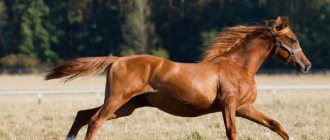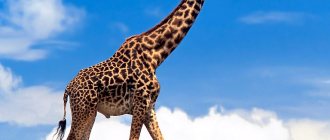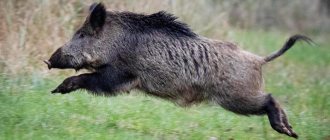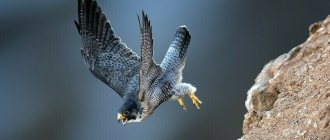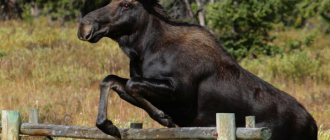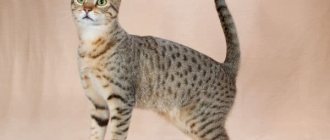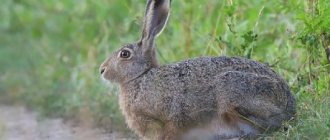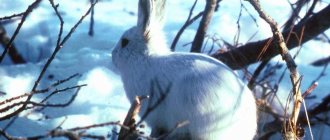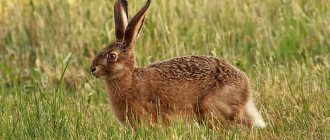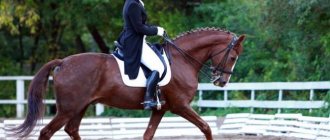What to feed a hare in winter?
What to feed bunnies? At this point you will understand that tree bark is far from a delicacy for these “cowards.” The brown hare is not a fan of trees at all. In winter, it greedily eats root vegetables, Jerusalem artichokes, cabbage, hay, leaves and rags, as well as the famous “brooms” made from thin birch twigs.
Interesting materials:
What is the name of a predatory plant that feeds on small animals? What is the division of consumers into different groups based on similar characteristics called? What is the name of the incision located at the site of the front view? What is the name of the reaction producing polyethylene? What is the name of the river from Frozen 2? What are billboard advertisements called? What is the name of my grandmother's sister? What is the name of a fish that inflates like a balloon? What do you call a fish that swells? What is the name of the fastest car in the world?
Maximum running speed of a hare km/h
As we have become accustomed to since childhood, all hares, or even bunnies, as children call them, are soft, fleecy creatures that jump carelessly on the grass and are scared of everyone until they faint, and therefore everyone strives to offend them. Most likely, we formed this opinion due to watching Soviet cartoons. In fact, everything is far from true. Hares are moderately aggressive and restless creatures that can easily fend for themselves.
For example, no self-respecting hunter will take a live hare by the ears, although they seem to be designed for this. Because hares have very strong paws, with which they can easily fight off an attacker, leaving a painful imprint on the body of a hunter or predator who decides to feast on them. They use this technique quite often, and in most cases they win.
By the way, scientists, who for a long time officially called all hares rodents, having learned in more detail about their behavior in stressful situations for them, separated the former rodents into a separate order of lagomorphs, deservedly determining that they still fall short of real predators.
The natural habitat of hares is the illuminated edges of deciduous and mixed forests and thickets of bushes.
Table of maximum speed of a hare km/h
Depending on their habitat, their name, diet and, accordingly, speed of movement vary.
| View | Maximum speed |
| White hare | 50-60 km/h |
| Brown hare | 50-60 km/h |
| Antelope hare | 60-70 km/h |
| Broom hare | 80 km/h |
From the table you can see that the speed of lagomorphs differs little from the speeds of the predators that hunt them. They are hunted by a huge number of animals, and the main reason why they have not yet been exterminated is the amazing speed of their reproduction.
Maximum speed of brown hare and hare
The cowardly animal runs quickly; its speed can reach up to 50-60 km/h, which exceeds the speed of a professional athlete. The white hare also runs along with it, whose speed also reaches 50-60 km/h.
hare Rusak
Most often, you can find this type of hares in Europe, Asia Minor and Asia Minor and North Africa, since these animals are native to the steppe.
Today they are widespread in forest-steppes, tundras and Europe, in the north to Ireland, Great Britain, Turkey and Transcaucasia. They can also occasionally be found in some areas of North Africa.
A hare of any species is a sedentary, territorial animal. It can live for a long time in the same area, 30-40 hectares in size, the duration depends on the abundance of food in the habitat. In other areas of their habitat, brown hares travel a long distance every day in search of food, and back to their roosting place.
The hare and hare feed on flowering plants and tree shoots. Thanks to their strong paws, they have the ability to dig up tree roots, but most often they eat leaves and stems. At the end of summer, planted plant seeds are dug up (due to the fact that food is not completely digested, they contribute to an increase in the number of vegetation). They eat vegetables and melons with pleasure, being a headache for many summer residents.
In winter, the brown hare, unlike the hare, does not deny itself feeding with seeds and the remains of garden crops, digging them out from under the snow. With deep snow cover, it switches to feeding on tree and shrub vegetation (shoots, bark).
Maximum speed of antelope and broom hares
The broom hare is the most unstudied and youngest species of hares. Little is known about the feeding, reproduction and behavior of this hare. It is assumed that all these characteristics of this species are similar to the brown hare. The habitat of this species is Spain, where it was first listed in the Red Book, and is one of the fastest and most protected species of lagomorphs. can reach speeds of up to 80 km/h.
The antelope hare can exist in a variety of habitats. It can inhabit grassy biotopes in both hilly areas and plains. They can adapt to life in desert areas. Very often they can be found in suburban areas, since this species has very quickly adapted to anthropogenic factors. Most often they can be found in the United States in the states of Arizona and Chihuahua and in Mexico. They are also herbivores, but in difficult conditions they can act as scavengers.
Why do you dream about a hare?
If in a dream you saw a hare running away from you, this means that you will mysteriously lose something valuable. If you catch a hare, this is a positive dream that indicates that you will win the competition. If hares are your favorite animals, you will be surrounded by nice, but not intelligent friends. Feed the hare - expect a quick marriage proposal.
In nature, hares are divided into about 30 subspecies, differing both in coat color and in lifestyle, diet, and speed of movement.
Fleet-footed animals
All hares are excellent sprinters. The amazing ability to run so fast in these small animals is developed due to the special development of the musculoskeletal system. The hind legs are long and muscular, which allows them to make huge jumps of 3-4 meters in length. The hind legs are also much longer than the front legs. This feature makes it possible to immediately develop enormous speed from a standstill. The maximum speed of the hare reaches 50 km/h already in the 5th second (!) of running.
Fox capabilities
The fox is a mammal from the canine family. Its sprinting abilities are due to its long hind legs and small stomach. The common or red fox can move at a maximum speed of 50 km/h.
The tail helps the fox maintain balance while running.
There is an individual with higher indicators - this is the gray fox. It is inferior to the previous species in size and is currently found in nature much less frequently due to the high popularity of its fur. The maximum speed that the animal can reach is 67 km/h.
How fast does a hare run?
These small animals have a specially designed musculoskeletal system that allows them to cover long distances in a short time. Hares have long and muscular hind legs, thanks to which they jump 3–4 meters in length. The forelimbs are much shorter. This makes it possible to develop significant speed from a standstill. A big advantage is the very structure of the paws - they are narrow and long, which provides reliable grip on the ground and effective pushes during jumping.
Who is faster
In the absence of the need to move at maximum speeds, the hare and the fox demonstrate approximately the same performance. If we compare the maximum capabilities of animals, then the hare has an undeniable advantage. His speed of movement in case of danger significantly exceeds the capabilities of the fastest fox.
When hunting a hare, the fox prefers to lie in wait for it or exhaust it with a long and difficult run.
So, both the hare and the fox are real sprinters. The first place is occupied by the hare, which can, if necessary, develop significant speed.
Hares are common on all continents, with the exception of Antarctica and Australia. Unlike rabbits, they do not dig holes for themselves, but make nests in holes.
The average size of the most common hare, the hare, is 65 cm at the withers, and the weight reaches 6-7 kg. The lifespan of animals in captivity is 5-7 years. Hares have relatively high speed as it is their survival strategy. The peak running speed of the brown hare is 70 km/h (19.5 m/s). The average running speed of hares is 50 km/h.
- Author: Maria Sukhorukikh
Nutrition
Brown hares are typical herbivores, eagerly eating a variety of grains, buckwheat, sunflowers, chicory, alfalfa, clover, rapeseed and dandelions. At night, in search of food, wanting to satiate its stomach, the brown hare travels up to several kilometers, testing the strength of its long legs.
Settling on agricultural lands, these animals can greatly damage the harvest of vegetable gardens, orchards and winter crops, actively eating human-grown grains and melons, vegetables and fruits. The proximity of Russians can be so unpleasant to human civilization that it often becomes a real disaster.
And in some countries, for example, in Australia, hare are even declared to pose a serious danger, pests. In winter, in the absence of adequate nutrition, the brown hare is content with gnawing the bark, often bringing not only bushes, but even large trees to a disastrous state.
These animals prefer to feast on broom, hazel, oak or maple, while white hares usually choose aspen or willow for their meals (and this is another difference between these bright representatives of the genus of hares).
Tearing up the snow with their paws, the hare diligently dig out plant food and tree seeds from under it. And other animals, for example, partridges, which are not able to clear snow on their own, often manage to benefit from the fruits of their efforts.
In the spring, hares actively eat young shoots of plants, their leaves and stems, often damaging the roots of shrubs and trees that are just beginning to grow, and in the summer they eat their seeds.
Reproduction and lifespan of the brown hare
Brown hares are quite fertile, but the number of offspring is highly dependent on the time of year, the age of the hare giving birth to offspring, and the climate of the area in which these animals live.
In Western Europe, on average, female hare breeds up to five litters per year. One litter can have from 1 to 9 hares. And the breeding season, coming with the arrival of spring, ends in September.
- Hare - types, diet, coloring, habitats, enemies, as well as interesting facts about animals
While in hotter countries it starts literally in January and continues until late autumn. The most prolific are middle-aged hares.
Gestation lasts 6-7 weeks. Before giving birth to rabbits, females build simple grass nests or dig small holes in the ground.
The newly born bunnies weigh on average about 100 grams, their body is covered with fluffy fur, and with wide open eyes they are ready to look at the world around them.
In the first days they feed on mother's milk, but after ten days they become so capable that they themselves try to absorb grass food, becoming more and more adapted to this type of food every day.
And at the age of one month they are ready to go out into the big and unfamiliar world to begin an independent adult life. The lifespan of hares is short-lived, and usually in the wild they rarely live more than seven years. In addition, quite a lot of animals die at an earlier age.
However, they reproduce extremely quickly, therefore, despite the fact that they are game animals, the population of hare is not in danger today.
Here are twenty-five of the fastest land animals living on our planet: 25. Giraffe
Giraffes are the tallest mammals living on our planet and the largest ruminants.
They are easily recognized by their long necks, the patterns that decorate their skin, and their incredibly long legs. But don't let their size and apparent clumsiness fool you; these gentle giants can reach speeds of up to 51 kilometers per hour. 24. Grizzly Bear
Bears are usually portrayed as gentle and sweet animals, but grizzlies have nothing to do with this image.
In life they can be incredibly ferocious and will defend their young or food to the death. Despite their size, they are capable of reaching speeds of up to 56 kilometers per hour. 23. Jackal
These canine predators are found in parts of Africa and south-central Eurasia.
Jackals are closely related to wolves, dogs and coyotes, and their running speed can sometimes reach 56 kilometers per hour. 22. Black-tailed deer
These mammals live in western North America, but in recent years they have successfully taken root in Argentina.
Deer usually serve as prey for pumas and lynxes, so running speed plays a vital role for them. Black-tailed deer can run up to 56 kilometers per hour, which allows them to sometimes successfully avoid early death. 21. Hounds
Hounds, or as they are also called, English Whippets, are descendants of the fastest-footed dogs on Earth.
And although this is a rather small dog, it is capable of covering a distance of 53 kilometers in an hour. 20. Mongolian kulan
This endangered species of kulan lives in East Asia, in Mongolia and Northern China.
It is capable of accelerating to 64 kilometers per hour. 19. Zebra
Black and white stripes on the skin of a zebra inspire not only fashionistas and art critics. Even the Mbombela stadium in South Africa is painted in these colors.
Zebras are also capable of reaching speeds of up to 64 kilometers per hour. 18. Hyena
Hyenas have always been known for their ability to produce sounds similar to laughter and giggles.
But this does not mean that they are funny and cute animals. These natural-born predators with powerful jaws are capable of developing breathtaking running speeds, reaching 64 kilometers per hour. 17. Thomson's Gazelle
Named after Joseph Thomson, a Scottish geologist and explorer, this gazelle is one of the most widespread subspecies, with a population of more than 500 thousand individuals.
Thomson's gazelles live mainly in the Serengeti. These gazelles are capable of reaching speeds of up to 65 kilometers per hour, overtaking the most persistent predators. 16. Gray Fox
The gray fox, which was considered the most primitive species of the canine family, is now considered a rare species due to the ruthless hunting for its fur.
The gray fox can reach speeds of up to 67.5 kilometers per hour and can also climb trees to avoid larger predators. 15. Greyhound
Greyhound is the second domesticated animal on our list.
Previously, this breed of dog was bred mainly for racing, but recently it has gained popularity as a pet. The greyhound can run at a speed of 69 kilometers per hour for 30 minutes and can accelerate to 32 kilometers per hour after running just 250 meters. This animal is the second on the planet (after the cheetah, of course) in terms of acceleration over short distances. 14. Onager
Another representative of equines is the onager.
This desert dweller can accelerate to 69 kilometers per hour. 13. Coyote
Also known as the American jackal, the coyote can reach speeds of up to 69 kilometers per hour and is capable of feeding on absolutely anything it finds, from insects to your pets.
12. Ostrich
This is the fastest and largest bird on the planet; the ostrich can accelerate to 70 kilometers per hour.
11. Red Kangaroo
These guys can jump at speeds of up to 71 kilometers per hour and maintain this pace for up to 2 kilometers.
The further he jumps, the less energy he uses. 10. Hyena-shaped dog
It, of course, looks like a hyena, but no, it is not a hyena.
The wild dog has many names, but this does not change the essence - these animals are capable of speeds of up to 72 kilometers per hour. 9. Wapiti
Don't let its size fool you, this second largest deer in the world can reach speeds of 72 kilometers per hour.
8. Black-tailed hare
Remember the fairy tale about the hare and the tortoise?
Although this is just a fairy tale, there is some truth in it. These small animals are capable of reaching speeds of 72 kilometers per hour and jumping up to 3 meters in height. 7. Lion
These regal cats are considered the second largest of their kind and can reach speeds of up to 80 kilometers per hour.
6. Garna
These Indian antelopes are listed as endangered by the International Union for Conservation of Nature.
Accelerating up to 80 kilometers per hour, these antelopes thus escape from wild cats and wolves hunting them. 5. Wildebeest
Although wildebeest look large and clumsy, they can accelerate up to 80 kilometers per hour.
4. Racehorse
Well-trained racehorses can reach speeds of up to 88 kilometers per hour.
3. Springbok
These small antelopes can accelerate to 100 kilometers per hour.
2. Pronghorn antelope
Unfortunately, we do not have sufficiently accurate measurements of the maximum speed of this antelope, but it has been recorded that it is capable of running at a speed of 98 kilometers per hour.
But we believe that she is capable of more. 1. Cheetah
Cheetah is the fastest land animal on our planet. It is capable of reaching speeds of up to 121 kilometers per hour. At this speed, it can run up to 500 meters and accelerate from 0 to 100 kilometers per hour in 5 seconds (an indicator that surpasses most sports cars). This is interestingpene4ka 1
Features of hares
Zoology distinguishes several species and subspecies of these animals. The planet is home to the Bushman hare, the bristly hare, the African hare, the climbing hare (or the Japanese arboreal hare, which is on the verge of extinction), the anuran and black-tailed hare, and more than a dozen species. Let's not forget, of course, our Russian bunnies - hare and hare.
Species differ in color, habitat, gastronomic habits, even blood composition. Common to all lagomorphs:
- the structure of the jaw, which allows for fractional grinding of solid plant foods (branches, tree bark);
- teeth wear down and grow throughout life;
- acute hearing and vision, especially well-developed sense of smell;
- the presence of special odorous glands for detection by relatives;
- excellent adaptability to running (the maximum speed of a hare can reach 60 km/h);
- terrestrial animals, do not climb and swim well;
- high fertility (the female produces up to 4 litters of 5-10 babies each year).
How scientists studied the maximum speed of a hare
Zoologists, studying the life of animals, pay great attention to their habits, behavior in groups and reactions to danger. The main methods of such study are observation, ambushes, photography, and video filming. Animals are also caught and equipped with special sensors. They record movement, speed, even the body’s physiological reactions to stress and danger.
It was with the help of such a sensor that the maximum speed of the hare was recorded. It is very difficult to take a photo of a hare running as fast as he can from danger. However, with the help of the latest cameras that record time and shoot 10 frames per second, it was possible to record the hare's speed record - 75 km/h.
In the animal world there are real sprinters who can develop great speed when necessary. The hare and the fox are worthy rivals, but one of them can run faster than the other. Zoologists know exactly who will win the sprint race.
Coyote.
The American wolf reaches speeds of up to 65 km/h. The coyote is omnivorous and extremely unpretentious in food. However, 90% of its diet consists of animal food: hares, rabbits, prairie dogs, marmots and ground squirrels (in Canada), small rodents. Attacks raccoons, ferrets, opossums and beavers; eats birds (pheasants), insects. Swims well and catches aquatic life - fish, frogs and newts. It rarely attacks domestic sheep, goats, wild deer and pronghorn. At the end of summer and autumn, it happily eats berries, fruits and groundnuts. In the northern regions in winter it switches to feeding on carrion; follows herds of large ungulates, eating the dead and cutting off weakened animals. Doesn't bother people; in the suburbs it sometimes rummages through the trash.
